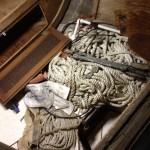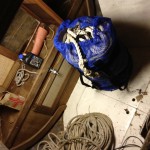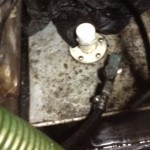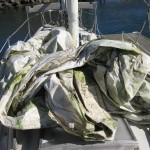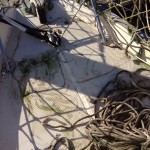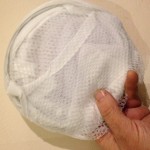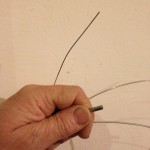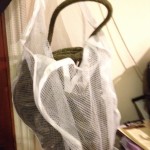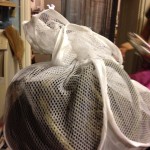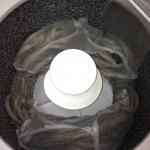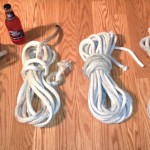Today I bought a gear puller set at Harbor Freight and successfully removed the harmonic balancer from the crankshaft. The alignment key didn’t want to come out though, but I don’t think that will interfere with the disassembly.
Tag Archives: cleaning
2012-12-14 Straightening up the Aft Cabin Anchor Rode
The Nor’sea Aft Cabin has been nicknamed the garage by some because it tends to collect all the sailing equipment, sails, anchors, lines, RIBs and other goodies. This post is about an attempt to address a big tangled pile of anchor rode.
Straightening up the Aft Cabin
Tonight I sorted out about 200 feet of anchor rode in the aft cabin and stored it in the anchor rode bag I bought today at West Marine. I like the bag material but the tie at the top is undersized for use with heavy lines or especially chain. I may pull it out and run a 1/4″ yacht braid or 3/16″ amsteel scrap through the hemmed border.
2012-12-12 Pumping out Diesel
Tonight Melissa and I pumped out the contents of the boat’s leaking aluminum fuel tank into five 5-gallon buckets. We harvested about 23 gallons. The first 20 were relatively clean and the last 3 came from the sump, so there was a lot of dirt, as well as the motor oil I let fall in there while removing the engine’s oil pan. Note to self: don’t ever do that again! Motor oil makes diesel look like honey! And, rather than mix freely with the diesel, it seems to float on top as a muddy goo.
I pumped from the white, plastic port on top of the tank, down through 25′ of clear 0.5″ tubing out the companionway and down the 7′ ladder to a small Harbor Freight fluid transfer pump connected to a short hose and the bucket. It took about 200 pumps to fill a single bucket. A drill pump would havd been handy, but tonight was intended as a dry run to see if I could pump that far (five feet up, seven feet down) without problems.
Anyways, the pump-out went pretty well, but when the flow slowed I had to remove the tubing from the tank and put a 3′ long, 1/4″ dowel inside it to keep it straight enough not to suck air. That worked pretty well until the tank got close to half full, and the hose fit too tightly and was creating a vacuum I had to work against. I pulled the hose out a few times to unlock the vapor lock, but disconnecting one of the tank fittings would have worked, too.
After the water and diesel had been pumped from the sump, the next layer was oily mud that coated the bottom and sides. I used a half roll of paper towels to clean out the crud, and sprayed in a lot of Formula 409 and left a rag overnight to sop up more of it. I am not entirely sure the bottom of the sump is really the bottom; I see a piece of wood and some kind of float switch down there. It might go another 3-4 inches below the board.
Now, five orange buckets line the driveway, and I am hoping to find somewhere that will accept them for recycling before they start to leak!
- Aluminum tank has been leaking diesel into the sump for some time.
- four buckets full of Diesel. A fifth is partially full, contains a mix of motor oil, dirty diesel and water.
2012-12-11 Update – Diesel and Trailer Supports
Progress has been a bit slow as we had a general cleanup project for an property appraisal for a bank refinance, and we’ve been hampered by weather. Things should pick up a bit, however.
Next on the project list is to get the diesel fuel out of the tank. It’s clear that the tank is leaking. I pumped out the sump a couple of times last week, and each time the bilge slowly refilled with diesel after a couple days. Then there was the fiasco with the motor that required that I drain the engine pan, and that might as well go in the sump, too!
I bought six 5 gallon orange buckets at Home depot, for $3 each, and lids for $2, and a length of 25′ 1/2″ OD hose to extend the length of the fluid transfer pump I got at Harbor Freight some time ago. My plan is to use that to start a siphon with the buckets down at the ground level. That way I don’t have to carry buckets of sloshy oil up the companionway ladder, across the cockpit and down the 7′ ladder. We do learn – slowly but surely. I’ll need to take the plastic inspection port cover off so I can tell how much oil is actually there. Then I’ll need to see if the recycling center will take the stuff. If not we can maybe have a big bonfire for the 12/21/12 end of the world Mayan festivities.
This is a prelude to the tank removal, which is the big job for Nor’seas. Right now my interest is primarily in getting the stinky, flammable stuff out of my work environment.
Trailer Support
Another important task is getting the weight off the trailer wheels. I located some Railroad ties at a nearby Home Depot. They measure about 7×9″ x 8 feet, and weigh about 160 lbs each. I have some help coming Saturday to take this one on.
The reason for the supports: A Nor’sea weighs in the neighborhood of 5 tons, plus the 1500 lb trailer that’s a significant load on each wheel and sprung suspension member. Ed Zacko helpfully provided some very detailed guidance on the Yahoo Nor’sea 27 Forum in response to my inquiry on November 30th.
Items Required:
- some fresh 6×6 RR Ties(Home Depot) Use a chain saw to cut them to 2 ft lengths
- a few pieces of FRESH 2×4—-1 ft lengths and 4×4’s as “shims” support at incremental levels or jack re-sets.
- two planks—we used 2×8’s—-to spread the load over a wide area—If you dont do this the Blocks will sink into the ground —almost immediately and you may not be able to remove the jack. — also–if you are on black top over time they will also want to sink in and ruin the black top.
Warnings
- choose a location that is not on top of submerged sewer lines, pipes, gas pipes, water Pipes etc.
- DO NOT use Cinder Blocks or Concrete blocks for this—they will crack and fail!
- DO NOT try to get a wheel off the ground in one go—you can put a lot of strain on the trailer and the hull—Take it easy and be patient.
- Jack up each wheel along the axle—as close to the spring as you can get–then add the blocks and lower GENTLY
Instructions:
- We always stored Entr’acte at 6 points. The trailer will be fine and stable and safe to store for long periods and also to work under.
- You will have blocks on all 4 (6) wheels.
- Block it up high enough so that the wheels can spin–that way you can easily remove the tires to service the brakes etc—The boat will settle over time—the planks will sink a bit and the wood will compress—especially over a long time.
We had a few pieces of steel “I” beam that we put down first then set the RR Ties into those—but 2×8 work just as well. - Add some blocks under the front of the trailer–just behind the brake actuator and also in the center of the last cross brace at the rear of the trailer—It’s amazing what can happen when one or two people go aft to do something—“Hey–hand me that sander–” and they step back to give it to you—-WATCH OUT for that.
- When you start to jack up you will realize just how heavy the NorSea is. You will have to go-incrementally from wheel to wheel–and remove the jack to re-set it—that’s why you have blocks of different thickness. Eventually you will get her where you want her.
- The first time you try this it takes some time and you have to be creative with the blocks and the screw out head of the jack. Do it wrong and you can’t get it high enough to put in a block and you can’t extract the jack—Over the years I got to know the process so well that I could actually get her up in less than an hour.
- In many ways it’s like raising your mast—you crank for a LONG time and it looks like it ain’t going anywhere—it just moves by mllimeters until you get it going
- Throughout the jacking process be prepared for a lot of creaking and groaning as you jack and also for a lot of crackling as the wood compresses. That’s why you want to use NEW wood and not some old stuff you have lying around—also the RR Ties are quite dense compared to other wood. It’s a bit disconcerting the first time you do it.
Take it easy –take it slow. Ed Zacko
2012-12-10 Line Cleaning
Beneath the mainsail, which was stored for a few years on the foredeck, the boat had several lines loose on deck. I was very skeptical about the sail’s chances. I was surprised that the algae and moss mostly cleaned right off, but the foot area shredded open.
The lines, as ugly as they look, had better prospects. Steve at Riverbend suggested putting them in the dumpster when he saw them, but instead, I put them through the wash. The problem with laundering anything like this (other than getting caught) is that the lines can get caught up on the washing machine’s agitator assembly and break something, or get abraded and tied in knots.
I sought to avoid this by putting them in some mesh bags, of the variety they pack oranges or potatoes in. Unfortunately I didn’t have a need for large quantities of produce, but I remembered seeing some mesh hampers for sale at the dollar store around the corner. I bought two of these and took out the metal stiffeners and clamps, leaving me with a large mesh bag that could accommodate a few, or perhaps 80′ of what I believe is 1/2 or 5/8″ line.
I used some plastic zip ties to close the top and put these in on the Grunge setting of the washer, which I set to extra large load and added a half cup of bleach on the Warm/Warm setting. A few minutes of agitation and the water was already black. This was exciting! I knew something was going to happen.
After the first cyle I looked in and already the lines were showing a great improvement. By the spin cycle the lines were just slightly damp, and all but the 3/8″ line were very clean relative to their former state. The mesh bag had torn, so I was just able to use the pair of bags one more time by slipping one inside the other.
The experiment was a great success. I should be able to get at least a few years’ use out of each of these.
- Unfortunately the mainsail had been stored on deck. The Oregon winter started a great crop of moss.
- Hidden, or protected? Underneath the mainsail were several lines that looked pretty questionable.
- Another look at the foredeck. Storing lines and sails like this does not just subject them to damage, but it can cause water to collect and pool on the deck, or block normal drainage paths entirely, resulting in mildew, deck rot and damage to the deck.
- These lines are black and don’t smell very good.
- An inexpensive mesh hamper – you could substitute an orange mesh sock or a gunnysack.
- unpackaged, it has some wire forms in place that let it spring into shape. These will need to be removed before washing.
- here are the frame parts pulled out. each wire is secured in a loop by a metal collar (shown)
- loading lines into the mesh bag, to be secured with a tye wrap
- tied up and ready for the plunge!
- shortly after the washer went into the agitate cycle, the water became black!
- The spin cycle is already promising, showing the two bags of clean lines.
- Ultimately I wound up with several serviceable lines. Because I tied knots in the unwhipped ends, fraying was kept to a minimum. I couldn’t really whip them as dirty as they were, but some tye wraps would have been a better idea.
2012-12-02 Work for Sunday – Cleanup and the Electrical Monster
Diesel in the Sump
The sump continues to collect diesel. I believe the water in the sump was displacing the diesel and now that it’s been removed the tank can leak freely. I need to empty the tank rather than continue sucking the leaky stuff out of the bilge. The problem is, I am not sure how much is there and how to go about properly disposing of it. My wife is getting sensitized to that diesel aroma. It takes about 3 washes to get it out of a pair of blue jeans. My GoJo hand cleaner works well for my hands.
Cleaning the Head
Continuing the cleaning process, I cleared out the head area. There’s no plumbing in here so it’s just kind of a closet with a big cutout in the wall for the holding tank. I found a tub of mixed hardware, many of which were mild steel drywall screws that had rusted. I did find a few jewels in there:
1) The mounts that secure the top of the companionway ladder were cleaned and installed. Now it’s not quite as scary decending the ladder!
2) Several of the strikers for the cabinets. These are just in fair shape, but it helps having the original equipment as a place to work from.
Lots of Formula 409 and scrubbing were required to restore the head to some kind of order. Packed away the following items:
- two marine fire extinguishers
- a big roll of 3″ wide fiberglass tape
- a couple blocks and strips of teak wood
- about ten bottles of gold and silver paint with some brusheds that the PO had used on the logo. I’ll give these to the Girl Scouts for Christmas projects.
The following items were trashed:
- lots of wood putty, silicone and so forth
- some sheets and discs of wet sandpaper
- a rusty sparkplug socket and a miscellany of rubbish
Electrical
The wiring is pretty nightmarish. The fuse panel is hanging from its hinges and I noticed it has both AC and DC breakers in the same box. That’s only marginally scary. The thing is the AC side is directly opposite the ground bus bar. About the scariest thing was the battery charger AC input was wrapped and taped and just kind of hanging.
I spent some time tracing out the wiring. That battery charger was actually pretty useful in that it allowed me to confirm which battery leads were which. The color means nothing, unfortunately. I wired in the group 27 12V battery I was using for the sump and played around with the panel. I found that by turning on the POWER switch and the CABIN lights I could get the cabin lights to turn on. Three interior lights and the forward Engine bay light was working. The rear one looks to be missing a bulb. I haven’t dared to try any of the other switches yet because there is a lot of abandoned wiring.
2012-12-01 Tarps and Cleaning
Saturday morning
Tarps!
I replaced the large 17×20 tarp with two smaller tarps. The big one had collected so much water that I need smaller tarps to let the cockpit drains and side drains do their work. I put a 9×12 on the main cabin, tented over the mast, and a 5×7 on the rear cabin.
Cleaning the Aft Cabin
Continuing the work of cleaning out the rear cabin I found
- Large fisherman’s anchor and rode
- Two danforth anchors, large and small
- Two big Coleman coolers with broken hinges. One has no latch. I will probably Craigslist these for free pickup by some fisherman
- A 1980 era VHF radio. This went straight into the trash
- Collection of teak and cabinet door bits. I was able to sort this out into some semblance of order. I also found one of the side stiles for the main companionway drop board. I am still missing a piece from the main companionway door and a stile from the rear companionway drop board
- I found the oval cutouts for the side of the engine bay
- big square boards that go at the bottom of the footwell
- a pair of men’s pants. Dickies – hey my size – 34″ x 30″
- Lots of running rigging or what may be either sheets or the mast raising kit? I am not sure.
- Crab traps, floats and line
- two nautical charts
- Zodiac raft with a repair in the bottom and a repair kit
Electrical – Getting the AC working
I used one of my camper 30A adapters to run AC into one of the two Marinco outlets on the starboard cabintop and the AC outlets in the main cabin and aft cabin now function. I have a worklight going and plugged a fan in the aft cabin to get some ventilation going in there.
Tunes
I used a gift certificate the kind folks at Cardica had given me a couple years back to buy some 6×9 speakers to install in the existing 6×9 cutouts in two of the kicker panels of the main cabin. Melissa and I ran over to Fry’s Electronics at 8:30 just before closing and selected a pair. I think having a stereo in there will make the work go faster. I’ll probably put the speakers in some garbage bags to keep them dry and functional until the dust moisture and excitement die down.
I found the sump cover in the hanging locker so I pulled that out to dry. The bottom looks pretty shot but I might be able to relaminate something so the teak pattern will match. same story with the two cabin sole sump covers around the mast.
Scary red wire
I found a particularly scary red wire that runs down the floor of the cabin and was drilled through and under the cockpit sole then back up the other side. I have no idea why they didn’t go through the cabinets 3′ away, but it’s perilously close to the edge of the boat. I’ll figure out if this is still needed and relocate it. the holes will need to be epoxy’d up… carefully!
Engine work
I picked up some Automatic Transmission Fluid and a battery bulb. Juergen a mechanic who was working on an old wood boat at Coyote Point marina suggested that I fill the cylinder with ATF or diesel fuel to try to get the motor unsiezed. I’ll try anything at this point: there is little risk! I spent almost an hour trying to find the spark plug before I remembered it was a diesel and doesn’t have one. D’oh! I removed the intake port and found it matched a gasket that was floating around the battery compartment, so it was nice to find a home for that. The intake valve looked to be closed but I wiped out some rust and put about 3 tablespoons in before it overflowed. Hours later it hadn’t gone down so I decided to have a look under the valve cover. There is very little vertical clearance in the engine bay. I had just enough room to remove the valve cover, if I tipped it just so. I found the engine appears to be at the end of its exhaust stroke. I’d have to open the other side to confirm. I couldn’t get the intake valve to move for the life of me. The springs are tough but not that tough. I could squeeze it a bit but I couldn’t push the valve stem down any. Nor could I convince the rocker on the other side to move. The valve cover incorporates a decompression lever intended to let you crank start the engine, but when I looked at it it appears it presses down on the exhaust valve stem, which isn’t much help.
On Sunday I pulled the exhaust side. I loosened four bolts and removed the exhaust manifold. I also had to loosen two hoses to pull away the exhaust. (It looks like there is a crack in the exhaust manifold unless it’s just a detail in the molding, but that’s a problem I am looking forward to having to deal with assuming I get the thing running.) They’re all 13 mm bolts, about 4″ long threaded in the lower inch, and I had to dig through my tools to find a 13. I have so many 12s and 14s it was driving me crazy! If found a 13mm socket with a 3/8″ drive and an extension bar. The first three came out rather easily, but the fourth was crazy hard. I had to brace myself into a knot and use my leg to push the handle of the wrench and it finally squeaked free. I am amazed Teresa Carey was able to tear her engine down to repair a bent connecting rod by herself, but I guess mine had an additional 10 years of corrosion working against me.
The gasket had some RTV on it and when the last screw came out there was some motor oil (very dirty motor oil) coming out of the passage. It stopped after I put the screw back in. at least there is some oil in there!
The intake port was wide open. However, the piston is probably near Top Dead Center (TDC) so it only took a few ounces to fill it. As I pushed the exhaust manifold out of the way I heard a few cups of water come rushing out. I don’t know if it was in the exhaust or raw water passages though. It would explain the engine being siezed.
I figure there are a couple options. Either the cylinder rings rusted in the cylinder wall due to some exposure to moisture, or the motor had some more catastrophic event like a thrown valve or broken connecting rod. I didn’t see metal flakes in the oil but I have not drained it yet.
The hope is that the oil in the cylinder will eventually creep down and lube things up enough that I can turn the main crank with a wrench. I still haven’t been able to find the starting crank. Juregen said it could take up to a week, so hold your breath and check back!

